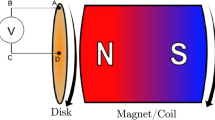Summary
Whenever the reaction forces between parts of an electric circuit have to be calculated, as in the design of railguns, a choice has to be made between three available formulae which have evolved during the past 160 years. The first was Ampère’s force law for the mechanical interaction between two current elements. Neumann then derived the virtual-work formula from what may be called the Ampère-Neumann electrodynamics. The last to be introduced was the Lorentz force law. This paper investigates whether both the Amperian and the Lorentzian forces are compatible with the virtual-work concept. The conclusion is that only Ampère’s formula agrees in all cases with the virtual-work idea, but in special circumstances the Lorentz law will give the same result. After demonstrating how Ampère’s law can be derived from the virtual-work formula, it is shown that for two closed circuits the relativistic component of the Lorentz force vanishes under the double integral around the two circuits. The remaining nonvanishing term is also present in the Ampère electrodynamics. This is not the case when considering the reaction forces between two parts of an isolated circuit. The Lorentz force is then, in general, not compatible with the virtual-work concept unless the circuit possesses a high degree of symmetry.
Riassunto
Ogni qual volta si debbano calcolare le forze di reazione tra le parti di un circúito eletrico, come nello schema di un railgun, si deve fare una scelta tra tre possibili formule che sono state sviluppate negli ultimi 160 anni. La prima è la legge di forza di Ampère per l’interazione meccanica tra due elementi corrente. Neumann derivò poi la formula del lavoro virtuale da ciò che può essere chiamata l’elettrodinamica di Ampère-Neumann. L’ultima ad essere proposta è stata la legge di forza di Lorentz. Questo lavoro indaga se sia le forze di Ampère che quelle di Lorentz siano compatibilit con il concetto di lavoro virtuale. La conclusione è che solo la formula di Ampère è in accordo in tutti i casi con l’idea del lavoro virtuale, ma in circostanze particolari la legge di Lorentz darà lo stesso risultato. Dopo aver dimostrato come la legge di Ampère possa essere derivata dalla formula del lavoro virtuale, si è mostrato che, per due circúiti chiusi, la componente relativistica della forza di Lorentz si annulla sotto il doppio integrale intorno ai due circúiti. Il termine che resta e non si annulla è anche presente nell’elettrodinamica di Ampère. Questo non accade quando si considerano le forze di reazione tra due parti di un circúito isolato. La forza di Lorentz è quindi, in generale, incompatibile con il concentto di lavoro virtuale a meno che il circúito possegga un alto grado di simmetria.
Резюме
При определении сил взаимодействия между частями электрической цепи следует сделать выбор между тремя имеющмися формулами, которые были развиты в течение прошедших 160 лет. Первая формула представляет выражение для силы. Ампера, для определения механического взаимодействия между двумя элементами тока. Затем Ньюман получил формулу виртуальной работы. Последняя формула представляет выражение для силы Лоренца. В этой работе исследуется вопрос совместимости сил Ампера и Лоренца с концепцией виртуальной работь. Вывод этой статьи заключается в следующем: только формула Ампера согласуется во всех случаях с идеей виртуальной работы, но в особых случаях сила Лоренца дает тот же результат. Продемонстрировав, как закон Ампера может быть получен из формулы для виптуальной работы, в статье показывается, что для двух замкнутых цепей релятивистская компонента силы Лоренца обращается в нуль при двойном интегрировании вдоль двух цепей. Оставщийся ненулевой член также присутствует в электродинамике Ампера. Рассмотренный пример отличается от случая, когда рассматриваются силы реакции между двумя частями изолированной цепи. В общем случае, сила Лоренца не совместима с концепцией виртуальной работы, если только цепь не обладает высокой степенью симметрии.
Similar content being viewed by others
References
P. Graneau:Nature (London),295, 311 (1982).
A. M. Ampère:Théorie mathématique des phénomènes électro-dynamiques uniquement déduite de l'expérience (Paris, 1958).
F. E. Neumann:Vorlesungen über elektrische Stroeme (Leipzig, 1884), p. 102.
J. Nasilowski:Exploding Wires, Vol.3, edited byW. G. Chase andH. K. Moore (New York, N. Y., 1964), p. 295.
H. G. Grassmann:Poggendorf's Annalen der Physik und Chemie,64, 1 (1845), English translation inR.A.R. Tricker:Early Electrodynamics (Oxford, 1965).
P. Graneau:IEEE Trans. Magn., to be published.
F. E. Neumann:Die mathematischen Gesetze der inducirten elektrischen Ströme (Berlin, 1845).
F. E. Neumann:Über ein allgemeines Prinzip der mathematischen Theorie inducirter elektrischer Ströme (Berlin, 1847).
O. D. Kellog:Foundations in Potential Theory (New York, N. Y., 1929), p. 53.
A. O’Rahilly:Electromagnetic Theory, Vol.1 (New York, N. Y., 1965), p. 102.
E. Whittaker:A History of the Theories of Aether and Electricity, Vol.1 (London, 1951), p. 84.
E. G. Cullwick:Proc. Inst. Electr. Eng., Monograph No. 150, September 1955.
V. Feilitzsch:Fernwirkungen des galvanischen Stromes (Leipzig, 1865), p. 211.
J. C. Maxwell:A Treatise on Electricity and Magnetism, Vol.2 (Oxford, 1873), p. 318.
C. Hering:Trans. Am. Electrochem. Soc.,39, 313 (1921).
S. Rashleigh andR. Marshall:J. Appl. Phys.,49, 2540 (1978).
F. F. Cleveland:Philos. Mag.,21, 416 (1936).
W. F. Dunton:Nature (London),140, 245 (1937).
S. B. L. Mathur:Philos. Mag.,32, 171 (1941).
I. A. Robertson:Philos. Mag.,36, 32 (1945).
W. G. V. Rosser:Contemp. Phys.,3, 28 (1961).
H. B. Dwight:J. Am. Inst. Electr. Eng.,46, 1238 (1927).
Author information
Authors and Affiliations
Additional information
Переведено редакцией.
Rights and permissions
About this article
Cite this article
Graneau, P. Compatibility of the Ampère and Lorentz force laws with the virtual-work concept. Nuov Cim B 78, 213–234 (1983). https://doi.org/10.1007/BF02721098
Received:
Published:
Issue Date:
DOI: https://doi.org/10.1007/BF02721098




